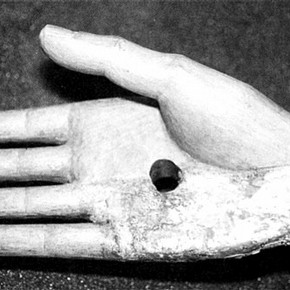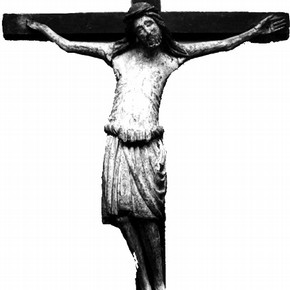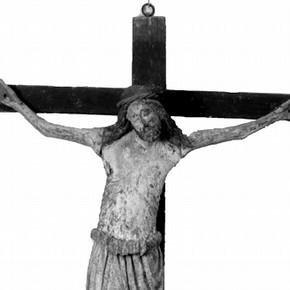Conservation Journal
July 1997 Issue 24
The Hand of God
A Crucifix figure, A2-1986, belonging to the V&A Sculpture Collection, came to Sculpture Conservation during a major refurbishment of Galleries 21-24 in 1995 (Figure 1). This 13th century wooden polychrome sculpture from Tuscany had been on open display for almost ten years, and was in need of cleaning and consolidation of the polychromy. Timber, paint and media analyses were also carried out at this time 1. This article is concerned with the restoration of the missing right hand.
The idea of making a new hand was first put forward by Paul Williamson, Curator, Sculpture Collection, V&A. It raised a variety of conflicting opinions about the restoration ethics of a very early and visually fragmentary object. Understandably, not everyone agreed with the final decision to restore the right hand. Carving the new hand from a suitable hardwood, rather than modelling and casting it, was found to be the most logical and ethical approach. The well preserved left hand was to serve as a model. The highly stylised carving of the left hand and the existing stump of the right hand gave sufficient indication of the appearance of the restoration. The various ways of attaching the newly carved hand were discussed in detail and the ease of the reversibility of the join between the original and the new was seen as paramount in deciding how to proceed.

Figure 2. Detail of the restored right hand. (Photography by Alexandra Kosinova) (click image for larger version)
Poplar, the wood of the figure, was the obvious choice for the replacement carving. Poplars are a large and widely distributed family throughout the northern hemisphere, chiefly in the temperate zone. They are fast growing, short lived trees. The wood is soft, with inconspicuous growth rings and light in weight. It is used as building timber, and for veneer and pulp. Poplar was the wood most commonly used for wooden sculpture during the Middle Ages and the Renaissance in Northern Italy 2. However, a seasoned piece of Poplar suitable for carving proved surprisingly difficult to find nowadays. Most timber suppliers in the UK offer tulip wood (Liriodendron tulipifera) as a substitute for Poplar. Tulip wood has the advantage of low density, but its greenish colour would have hampered the final colour matching. European lime wood (Tilia family) was considered next, as it is the common carving timber of the Central European region. Lime (linden) has been used by carvers since the Middle Ages and its qualities are well recognized by modern carvers throughout Europe and North America. About 20 species of lime are known. The wood is light and soft, with a pleasant pale colour, and carves easily. A North American variety of lime, basswood (Tilia americana), was eventually selected because of its very low density, imposing minimum extra weight on the fragile stump of the right hand. Basswood has the added advantage of a light, neutral colour that can be successfully stained to match the colour of the original 3. A piece of seasoned basswood was purchased from a specialized wood carvers' supply store in Victoria, British Columbia.
The carving of the hand started from a series of drawings based on the original left hand, drawn in reverse. A template was then cut out and transferred onto the wood. The construction of the new hand was to copy the original left one, i.e. the four fingers and the palm were to be carved in one piece, the thumb carved separately and fitted on afterwards. However, the existing stump, roughly one half of the right palm, also had to be accommodated. The palm and the four fingers were carved first, with the measurements taken with callipers from the left hand. The spaces between the four fingers were initially cut with a saw, copying the technique used on the left hand. After cutting with the saw, the spaces between the fingers were further worked with a chisel. The new hand was then cut into two pieces to fit around the original stump. The first piece included half of the palm with the forefinger, the middle finger and the ring finger. A dowel was made from the same wood to fit the existing hole, left by the previous restoration, where a ring finger would have been. A matching hole was drilled into the newly carved ring finger, the dowel was inserted in place and the whole piece was adhered with a mixture of poly(vinyl acetate) emulsion, wood dust and whiting. The same mixture was also employed as a filler in the gaps. The second piece was the little finger attached with a basswood dowel. The dowel fitted into the existing hole in the stump and a hole drilled in the new little finger. The same adhesive/filler was used. The thumb was carved from another piece of basswood with the help of callipers only. It was adhered to the newly carved part of the palm with poly(vinyl acetate) emulsion, without having to stick it to the original. The same filler was used for the gaps.
The details of the carving, such as the fingernails of the thumb, were completed after the hand was assembled. The options for the visual integration were discussed with the curator at this point. It was obvious that the very pale basswood needed to be colour matched. At the same time it was felt that for ethical reasons the restoration should not be completely disguised by retouching. A compromise was reached, of sealing and staining the hand. The wood was sealed with lemon shellac in ethanol and stained by acrylic based wood stains. Further adjusting of the colour was achieved with watercolours (Figure 2).
The Crucifix is now back on display in Gallery 22. The restoration has, at least for some, brought more unity to the object and made it more appreciable (Figure 3).
Acknowledgements
I am grateful to Paul Williamson for his ideas and support throughout this project. My thanks also extend to Albert Neher from Furniture and Woodwork Conservation Section for his advice on staining wood.
References
2. Kosinova, A., article submitted for publication by the UKIC.
July 1997 Issue 24
- Editorial
- Managing to be 'Tackless'
- The Initial Conservation of an Archive of Rolled Architectural Drawings
- The Hand of God
- The Conservation of Nineteenth Century Dissected Puzzles
- Conservation and Mounting of Leaves from the Akbarnama
- The Coronation of the Virgin - a Technical Study
- Painting in Japan
- Printer Friendly Version

